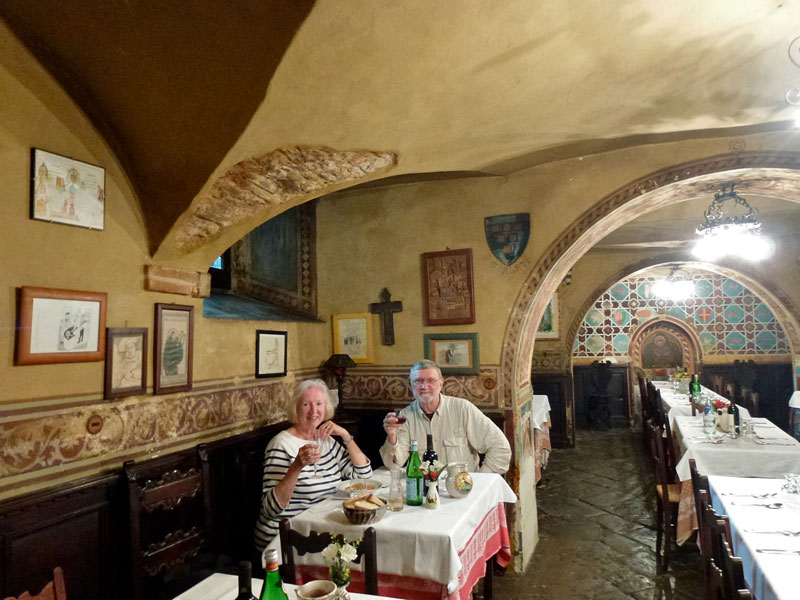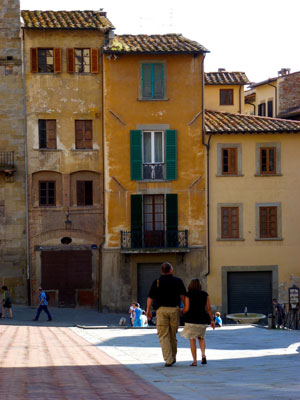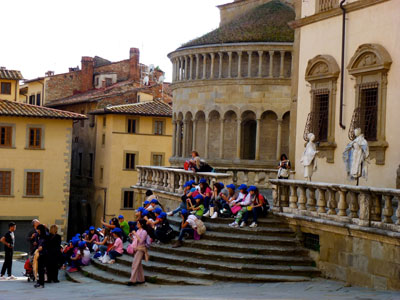Impressed with the quaint Italian town of Arezzo
This article appears on page 16 of the July 2014 issue.
Margo Wilson; Scottsdale, AZ
After spending time in many of the tourist-laden cities of Italy, I found the town of Arezzo to be an unexpected (and untouristed, at least in early May) exposition of medieval and Renaissance architecture and art.
My husband, Thom, and I reveled in the compact walkability of its walled Old Town during our 2013 visit.
The sights
Although Florence is only 48 miles away and crowded Cortona only 16 miles, their crowds will not join you in Arezzo… unless you happen to visit during the medieval festival called the Joust of the Saracens, which takes place on the third Saturday of June and the first Sunday of September.
For this spectacle, held in the Piazza Grande, “knights” on horseback representing different areas of the town charge at a wooden target attached to a carving of a Saracen king and score points according to accuracy, while residents dressed in medieval costume cheer their local heroes.
We saw a great deal on our one-day visit, but two or three days would have allowed us to explore the eight nearby Chianti producers and see the Roman amphitheater and Santa Croce church, located outside the city walls.
Arezzo dates from Etruscan and Roman times and is noted for its preserved medieval center and Renaissance art. Combining the two is the remarkable 13th-century Basilica of San Francesco, with the splendid, recently restored “Legend of the True Cross” frescoes by Piero della Francesca.
Although the number of visitors allowed in the chapel at one time is limited to 25 and reservations are usually required, in early May we simply walked in as soon as we got off the train and dropped our luggage at our hotel on the way. Very few people were there, so we were able to spend as much time as we wanted studying the frescoes on the walls and ceiling.
Another interesting site was the medieval house of Giorgio Vasari, an early-Renaissance painter and architect and the author of the first noted work on art history. Many of the walls and ceilings of the house are covered in frescoes; other rooms display Vasari’s collection of paintings.
The Piazza Grande showcases six centuries of architectural development, with houses from the 12th and 13th centuries situated next to palazzi with towers and Gothic and Renaissance façades. On the Loggia de Vasari, we sat with a drink and took in the beauty of the square and the everyday life of the town.
We visited many more churches, viewed the Tuscan countryside from the upper level of the town and admired the palazzi with their informative nameplates.
Shops offered all the Tuscan specialities, but the town is not a Disneyland of Tuscan tourism. There were delis, hardware stores, supermarkets and all the things a real town needs.
Dining out
We were pleased with our stay at the quirky Vogue Hotel (Via Guido Monaco, 54), where every room is themed. We were in the “Botticelli” room, which had an amazing bathroom with a tub surrounded by multicolored lights. The hotel was only two blocks from the train station and perfectly located for explorations of the Old Town. Our cost was €121 ($166) including tax and breakfast.
Buca di San Francesco (Via S. Francesco, 1) was an absolutely charming restaurant, and its simpatico owner provided a wonderful dining experience for us.
We each selected a different version of the menu for the day and were delighted with what we chose as well as with the little surprises we received. First was a complimentary appetizer of panzanella, a bread salad prepared by Mario de Filippis, the owner. (He also gave me the recipe.)
My ribollita (a hearty soup) and pork dish were typically Tuscan, and the little honey cake was delicious. Then came the vin santo (dessert wine), a nice ending to the meal.
When we refused coffee, Mario appeared with two coffee cups… with a Perugina chocolate in each one. Along with our bill of slightly under €50, which included two half carafes of wine (one red, one white), we received an envelope with sample prints of Mario’s collection of ex libris bookplates. The walls of the cellar restaurant were liberally decorated with them, along with many other interesting items.
The cellar was a rich visual experience, and the dining experience was delightful and one that I would love to repeat. In fact, I want to go back to Arezzo for all of the above reasons!



